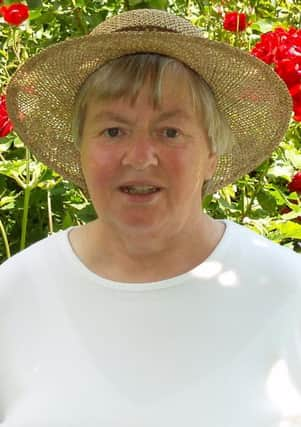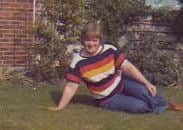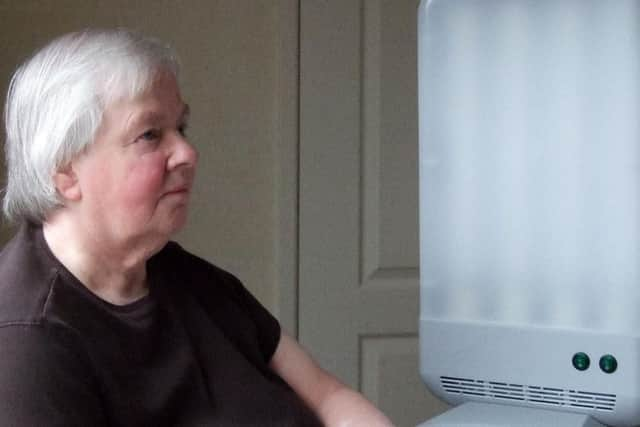SAD stories: Light at the end of the tunnel after decades of depression


EVER since she was a little girl, Susan Wilson has been aware of a blackness which has surrounded her life and clouded it with darkness.
Susan, now 71, who lives in Hesketh Bank, near Preston, recalls: “I have had depression as long as I can remember from being a little girl.
Advertisement
Hide AdAdvertisement
Hide Ad“I remember there being this blackness that was always there, especially when I woke up in the morning.


“I felt this blackness just in front of me and it was like it was in the middle of my forehead.
“I called it my ‘black dog’. It was always there and I was always afraid of it.”
Susan and husband Peter, who are now retired, used to work for themselves in agriculture and horticulture and spent a lot of time in the outdoors.
Advertisement
Hide AdAdvertisement
Hide AdHowever, it was only a few years ago that Susan made the connection that she may have Seasonal Affective Disorder (SAD) after years of suffering.


Susan explains: “I had been going to the doctor for depression for many years.
“It started off affecting my life now and again when I was in my teens, but it was in my 20s that I began getting it really bad.
“I went all over the place to see specialists, but nothing seemed to help.
Advertisement
Hide AdAdvertisement
Hide Ad“My mother had the same condition, but again, we did not know what it was.


“It is only now in retrospect that when I look back at the times I have gone to the doctors because things have been really bad that I realise it always seemed to be around January or February.
“Again, when I think back to my mother, I realise she was at her worst around February.”
Susan only realised a few years ago that her darkness was triggered by SAD. And she noticed that her symptoms would be even worse and longer lasting after a particularly poor summer.
Advertisement
Hide AdAdvertisement
Hide AdSusan explains: “I have thought for the last few years that I must have SAD.


“But before that, it was awful as I didn’t know what was causing me to feel this way.
“My SAD symptoms normally start around August or September and begin to lift around march.
“But if we get a poor summer with poor light, I am even worse in the winter.
Advertisement
Hide AdAdvertisement
Hide Ad“I can suffer with it in the summer too if we have a prolonged spell of low light.”
Susan says the way SAD affected her became so bad, she describes it as “destroying” her.
And with the bad summer and winter we experienced this past year, Susan found things acummulated and she reached rock bottom.
She explains: “Myself and my husband are into wildlife photography and we went to Scotland for 12 weeks over the summer.
Advertisement
Hide AdAdvertisement
Hide Ad“However, the light was terrible and it never stopped raining.
“So I have been really bad since August and have been a wreck and things got so bad, it destroyed me.
“It is on the really dark days when I am at my worst and I can cry for days on end.
“It also affects my sleeping and I was having a terrible time and not being able to sleep.
Advertisement
Hide AdAdvertisement
Hide Ad“I was up in the night crying and was suffering a lot of anxiety.
“I would be wide awake and tossing and turning all night and then be shattered during the day.
“I was in a terrible state and just could not cope at all and things reached a stage where I just could not carry on any longer.”
Susan has tried many different things over the years including various medication, but has found nothing has helped her for any period of time.
Advertisement
Hide AdAdvertisement
Hide AdShe says: “Exercise helps, but when you are not sleeping, you don’t feel like exercising.
“Meditation helps a bit, but it was still not the answer.”
Susan says she is always on the Internet looking for ideas for anything that can help her and it was through this, that she first heard about light therapy.
At first, she was dismissed it and was dubious, but a few weeks ago, she became so desperate, she thought she would try it and went to The Sad Light Hire Company in Southport and rented a lightbox.
Susan says: “I have only been using the lightbox for two weeks, but already it is making a difference.
Advertisement
Hide AdAdvertisement
Hide Ad“As soon as I open my eyes, I put the lightbox on for half an hour. I have it at the side of my bed.
“It seems to have regulated my sleeping patterns and my mood feels a lot better.
“I have not had any depression since I started using it and the blackness seems to have gone.
“From photographs, you can see I look a lot brighter when the skies are clear.
Advertisement
Hide AdAdvertisement
Hide Ad“I do not sit in the sun at all, nor do I go out without my head and arms covered on a sunny day.
“With me it’s the quality and length of good light that lifts my mood.
“I only tried light therapy because I had no choice as things were so bad and I had reached an ultimate low.
“Even though it is still early days, it seems to be working wonders for me.
“I just wish I had tried it earlier.”
Advertisement
Hide AdAdvertisement
Hide Ad• Light therapy has been shown to be effective in up to 85 per cent of diagnosed cases of SAD
• This involves daily exposure to very bright light, at least 10 times the intensity of normal domestic lighting
• Ordinary light bulbs and fittings are not strong enough. Under average domestic or office lighting, we receive an intensity of 200 to 500 lux, but the minimum dose necessary to treat SAD is 2,500 lux.
• The light intensity of a bright summer day can be 100,000 lux
Advertisement
Hide AdAdvertisement
Hide Ad• Most modern lightboxes are designed so that the user receives 10,000 lux and this has reduced treatment time
• Light treatment should be used daily in winter and in dull periods in summer. It should start in early autumn, for some as early as August when the first symptoms appear.
• It consists of sitting two to three feet away from a specially designed light box allowing the light to shine directly through the eyes.
• The user can carry out normal activity such as reading, using the computer or eating breakfast while in front of the box. It is not necessary to stare at the light although it has been proved safe.
Advertisement
Hide AdAdvertisement
Hide Ad• Treatment is usually effective within three or four days and the effect continues provided it is used every day.
• Tinted lenses or any device that blocks the light to the retina of the eye should not be worn
• Treatment at 10,000 lux can be as little as half an hour once or twice a day. Severity of symptoms may vary from person to person so some people may need more such as one to two hours
• Lightboxes are not available on the NHS and are sold mainly by specialist retailers. They are free of VAT for bona fide patients and start at around £100.